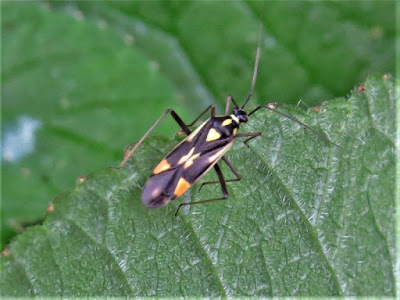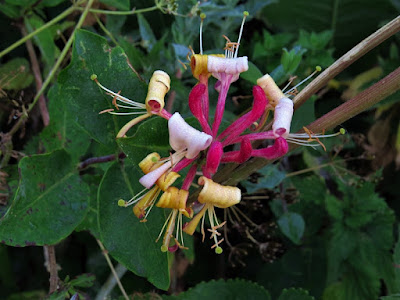13.0°C > 16.0°C: Some medium cloud early before a bank of mist rolled in from the East. This lifted only slowly and it remained overcast. Light winds, Moderate / good visibility.
Sunrise: 04:46 still
* = a photo today
Priorslee Lake: 04:40 – 05:40 // 06:50 – 09:25
(147th visit of the year)
Bird notes:
- An unsexed Tufted Duck flew West at 05:05. A duck Tufted Duck circled before settling in the water at 05:20: I did not see it again. A drake Tufted Duck flew West at 06:55.
- Back to nine Great Crested Grebes. For a while c.05:15 there appeared to be four pairs sitting close to each other in the middle of the water. Some chasing ensued as did some desultory display. It is difficult to be sure with this submarines species but they looked to be swapping partners at times. Later a ninth emerged.
- I accidentally flushed an Oystercatcher off the SW grass at 05:00. It is not as if they are well-camouflaged!
- After several days of only intermittent song I did not hear the Cetti's Warbler at all today.
- Two Garden Warblers heard singing: one of the regular songsters and one where I suspect breeding is taking place.
- Two juvenile Common Whitethroats were travelling together around their presumed natal site. A male still display-flighting.
Birds noted flying over here:
- 2 Tufted Ducks: singles – see notes
- 2 Stock Doves: singles
- 4 Wood Pigeons only
- 2 Collared Doves: singles
- 5 Herring Gulls again
- 13 Lesser Black-backed Gulls
- 1 Grey Heron
- 24 Jackdaws
- 4 Rooks again
Hirundines etc. noted:
- 5 Swifts
- 2 Barn Swallows
- 3 House Martins
Warblers noted (figures in brackets relate to singing birds):
- no Cetti's Warbler
- 7 (7) Chiffchaffs
- no Sedge Warbler
- 13 (10) Reed Warblers
- 10 (8) Blackcaps
- 2 (2) Garden Warblers
- 3 (1) Common Whitethroats
Counts from the lake area:
- 2 + 4 (1 brood) Mute Swans
- 12 (9♂) Mallard: also 1 (1♂) on a roof in Pitchford Drive
- 1 (0♂) Tufted Duck, briefly: see notes
- 2 Moorhens again
- 36 + 23 juvenile Coots
- *9 Great Crested Grebes
- 1 Oystercatcher: departed
- 2 Lesser Black-backed Gulls: immatures, separately, briefly
- 1 Grey Heron
Noted on / around the street lamp poles pre-dawn:
- *1 Straw Dot moth (Rivula sericealis)
- *1 Bridge Orb-web Spider (Larinioides sclopetarius)
- 1 Noble False Widow spider (Steatoda nobilis)
- 1 Tetragnatha sp. stretch spider
Noted later:
Things found new for this year:
Bugs:
- *Mirid bug Grypocoris stysi
- *possible lacewing larva
Flowers:
- *Creeping [or Common Field] Thistle (Cirsium arvense)
- *Greater Plantain (Plantago major)
- *Wood [or Red-veined] Dock (Rumex sanguineus)
- *Scentless Mayweed (Tripleurospermum inodorum)
Repeat sightings:
Butterflies:
- Ringlet (Aphantopus hyperantus)
Butterflies:
- Ringlet (Aphantopus hyperantus)
Moths:
- Common Nettle-tap (Anthophila fabriciana)
- *Common Marble (Celypha lacunana)
- Garden Grass-veneer (Chrysoteuchia culmella)
Plus the usual unidentified moths flushed from the grass.
- Common Nettle-tap (Anthophila fabriciana)
- *Common Marble (Celypha lacunana)
- Garden Grass-veneer (Chrysoteuchia culmella)
Plus the usual unidentified moths flushed from the grass.
Bees, wasps etc.:
- Buff-tailed Bumblebee (Bombus terrestris)
- Buff-tailed Bumblebee (Bombus terrestris)
Hoverflies:
- Marmalade Hoverfly (Episyrphus balteatus)
- Tapered Dronefly (Eristalis pertinax)
- Chequered Hoverfly (Melanostoma scalare)
- *Common Twist-tail (Sphaerophoria scripta) [was Long Hoverfly]
- Marmalade Hoverfly (Episyrphus balteatus)
- Tapered Dronefly (Eristalis pertinax)
- Chequered Hoverfly (Melanostoma scalare)
- *Common Twist-tail (Sphaerophoria scripta) [was Long Hoverfly]
Other flies:
- Black Snipefly (Chrysopilus cristatus)
- *Dagger fly Empis tessellata
- Black Snipefly (Chrysopilus cristatus)
- *Dagger fly Empis tessellata
Beetles:
- pollen beetles everywhere adding Meadowsweet (Filipendula ulmaria) and Nipplewort (Lapsana communis) to their repertoire. Of course it is equally possible that different cryptic species are plant specific and I am seeing several different species.
Bugs:
- Common Froghopper (Philaenus spumarius)
Wednesday's unknown micro-moth has been identified as a well-marked example of a London Dowd (Blastobasis lacticolella). Thanks to the Shropshire micro-moth recorder for the help.
- pollen beetles everywhere adding Meadowsweet (Filipendula ulmaria) and Nipplewort (Lapsana communis) to their repertoire. Of course it is equally possible that different cryptic species are plant specific and I am seeing several different species.
Bugs:
- Common Froghopper (Philaenus spumarius)
Wednesday's unknown micro-moth has been identified as a well-marked example of a London Dowd (Blastobasis lacticolella). Thanks to the Shropshire micro-moth recorder for the help.
Just a few clouds at dawn though note in the distance the bank of low cloud and mist that soon rolled in.
Four pairs of Great Crested Grebes were on the water early on with some chasing and perfunctory display. A ninth bird watched from the side-lines. Much later this one pair decided to go the whole hog with display including a brief weed dance.
A Common Marble moth (Celypha lacunana). It is looking at me.
Another moth looking as if it doesn't trust me. It is a Garden Grass-veneer (Chrysoteuchia culmella) in a more normal setting than the one I photographed on a car door frame yesterday.
A rare photo of a Straw Dot moth (Rivula sericealis) the right way up (and covered in dew) [and no: I did not invert the image].
When I saw this small hoverfly land on the grass-head I assumed it was going to be a Chequered Hoverfly (Melanostoma scalare) - this group are called 'grass hoverflies'. Then I noticed the scutellum (the half moon-shaped area between the thorax and the abdomen) was yellow and the thorax had faint stripes. The abdomen pattern is hard to see but seems to have yellow bands. These features suggest this is a Common Twist-tail (Sphaerophoria scripta).
A fairly innocent-looking fly until...
..a side-view reveals its long sucking mouthparts identifying it as one of the dagger flies, in this instance Empis tessellata.
A smart Mirid bug Grypocoris stysi. Apparently a common bug. It is in my master file with no date so I either saw it many years ago or I forgot to add the date when I entered it.
Now this creature has me perplexed. I think it is drinking the dew from grass. My best guess would be a lacewing larva. I cannot find many illustration to help me with a better ID.
A Bridge Orb-web Spider (Larinioides sclopetarius) silhouetted against the sky at dawn.
As it moves off some of the web outliers that are supporting it become visible.
This is Creeping [or Common Field] Thistle (Cirsium arvense). The flowers are paler and less clustered than those of Marsh Thistle (Cirsium palustre). The leaves are not as vicious as Spear Thistle (Cirsium vulgare).
Not yet in what passes for flowers in this group of plants is a Greater Plantain (Plantago major).
In yesterday's text for the tiny flowers of I suggested that other plants in the genus Rumex (docks) did not show flowers. I was wrong. This is Wood [or Red-veined] Dock (Rumex sanguineus) with its tiny yellow flowers. Of course you can't have dock plants with masses of seeds unless there have been flowers to be pollinated. Basic biology lesson needed.
The App. gave me the options of Scentless Chamomile or False Mayweed that I found growing on the verge of Castle Farm Way in ground disturbed by the roadworks. Neither name is in my Flora but the scientific name given for the former, Tripleurospermum inodorum, translates to Scentless Mayweed which seems to match both photos on the web and my Flora. It was certainly scentless (as far as my rather insensitive nose tells me anyway).
Today's rather poor aircraft of the day on a morning with a low overcast. It is a Eurocopter built Aérospatiale AS 355NP Twin Squirrel (twin engined) operated by Cameron Charters LLP., Knutsford. There has been many more helicopters than usual today, probably in connection with the Glastonbury Festival. No doubt for the artists and not the punters.
(Ed Wilson)
The Flash: 05:45 – 06:45
(Ed Wilson)
------------------------------------------------------------------------------------------------------
(143rd visit of the year)
Bird notes:
- The Peacock was waking the neighbourhood at 05:45.
- At last: I have re-found the Canada Goose goslings.
- Did I see the two large ducklings? Two birds were loosely with a pair of adult Mallard and so well-grown they could almost have been adult ducks. Meanwhile five small ducklings were possibly yet another new brood.
- I reconfirmed there are five juvenile Coots in the second brood by one of the footbridges.
Birds noted flying over here:
- 2 Jackdaws: singles
Hirundines etc. noted:
- 1 House Martin only
Warblers noted (figures in brackets relate to singing birds):
- 4 (4) Chiffchaffs
- 2 (2) Blackcaps
Noted on / around the water:
- 217 + 8 (2 broods) Canada Geese
- no Canada x Greylag Goose seen
- 59 Greylag Geese
- 7 + 4 (1 brood) Mute Swans
- *21 (16♂) + 7 (2 broods) Mallard
- 1 all-white duck (Aylesbury Duck)
- 8 (6♂) Tufted Duck
- 12 + 7 (4 broods) Moorhens
- 17 + 9 (3 broods) Coots
- 3 Great Crested Grebes again
- no Grey Heron
Noted on / around the street lamp poles or elsewhere
- *1 Tetragnatha sp. stretch spider (with prey)
Noted elsewhere:
- *Great [Hairy] Willowherb (Epilobium hirsutum)
- *Honeysuckle (Lonicera periclymenum)
Bird notes:
- The Peacock was waking the neighbourhood at 05:45.
- At last: I have re-found the Canada Goose goslings.
- Did I see the two large ducklings? Two birds were loosely with a pair of adult Mallard and so well-grown they could almost have been adult ducks. Meanwhile five small ducklings were possibly yet another new brood.
- I reconfirmed there are five juvenile Coots in the second brood by one of the footbridges.
Birds noted flying over here:
- 2 Jackdaws: singles
Hirundines etc. noted:
- 1 House Martin only
Warblers noted (figures in brackets relate to singing birds):
- 4 (4) Chiffchaffs
- 2 (2) Blackcaps
Noted on / around the water:
- 217 + 8 (2 broods) Canada Geese
- no Canada x Greylag Goose seen
- 59 Greylag Geese
- 7 + 4 (1 brood) Mute Swans
- *21 (16♂) + 7 (2 broods) Mallard
- 1 all-white duck (Aylesbury Duck)
- 8 (6♂) Tufted Duck
- 12 + 7 (4 broods) Moorhens
- 17 + 9 (3 broods) Coots
- 3 Great Crested Grebes again
- no Grey Heron
Noted on / around the street lamp poles or elsewhere
- *1 Tetragnatha sp. stretch spider (with prey)
Noted elsewhere:
- *Great [Hairy] Willowherb (Epilobium hirsutum)
- *Honeysuckle (Lonicera periclymenum)
Yet another new brood of Mallard ducklings? Five here looking very small but happily tucking in to the weed.
At first sight this looked like a long-legged fly when in fact it is a Tetragnatha sp. stretch spider with prey. There seems to be at least three wings involved which suggests the spider caught a moth – flies only have two wings.
The flowers of Great Willowherb (Epilobium hirsutum), or as the App. calls it Great Hairy Willowherb.
I did not need the App. to identify this as Honeysuckle (Lonicera periclymenum).
(Ed Wilson)
------------------------------------------------------------------------------------------------------
- Two adult and five juvenile Moorhens at the lower pool with other juvenile calls heard.
- No warblers seen or heard
(Ed Wilson)
In the Priorslee Avenue tunnel:
- just a few midges
------------------------------------------------------------------------------------------------------
- just a few midges
(Ed Wilson)
------------------------------------------------------------------------------------------------------
On this day can be found via the yearly links in the right-hand column.
Sightings from previous years without links are below
2011
Priorslee Lake
Common Sandpiper - First returning
(Ed Wilson)
2008
Priorslee Lake
Common Sandpiper - First returning
(Ed Wilson)
2006
Priorslee Lake
1 drake Ruddy Duck
1 Snipe
1 Common Sandpiper - First returning
At least 38 Swifts
(Ed Wilson)




















